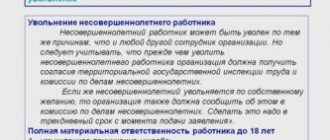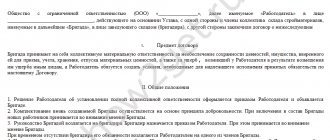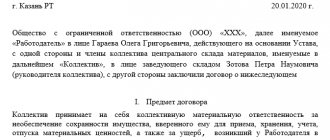Provision on liability
The Regulations on Material Liability of Employees (PMR) contains internal aspects of the company regarding the safety of its property. This document is a local document of the organization, which describes the scheme of interaction between the employer and employee in terms of the safety of the company’s property. The provision also contains specifics for compensation for damage.
The mandatory preparation of a document is not provided for by law, and there are also no special requirements regarding the content and scope of this document. This document provides for the same approach to all employees of the company regarding their responsibility for the safety of property. It also contributes to the absence of disagreements between the employer and employee in matters of compensation for losses.
Important! The issue of financial liability may also be contained in other company documents, for example, in an employment contract or an agreement on financial liability.
SAMPLE POLICY
Document structure
Since officials have not developed a standard form for such a provision and, in principle, do not require its existence, the employer has the right to write whatever is necessary. The main rule is that all norms of the document must comply with labor legislation and not impose on employees financial liability (full, limited or collective) higher than that provided for in the law. Therefore, before you start writing the text, you will have to study (at a minimum):
- Section XI of the Labor Code of the Russian Federation;
- Resolution of the Ministry of Labor and Social Development of the Russian Federation dated December 31, 2002 No. 85;
- Resolution of the Plenum of the Supreme Court of the Russian Federation dated November 16, 2006 No. 52.
And in order to prevent violations of the labor rights of subordinates and not limit your own, we recommend that you consult with a legal service or a third-party lawyer before approving the LNA.
What should be included in the provision? It is advisable to write in it:
- rights and obligations of employees and department heads as representatives of the employer;
- a list of situations when limited (within the average monthly salary), full or collective responsibility occurs;
- a list of employees of the enterprise with whom appropriate agreements on financial liability must be concluded when hiring (can be in the form of an appendix);
- a list of works for which workers are subject to financial liability (can be a separate appendix);
- the procedure for conducting scheduled and unscheduled inventories to keep records of material and technical assets;
- mechanism for pre-trial punishment of subordinates;
- circumstances under which financial liability does not arise.
Please note that the employer has the right not to impose punishment. But in this case, the approach to employees must be uniform so that management cannot be suspected of discrimination.
The legislative framework
When drawing up a PMO, one should be guided by the Labor Code (Articles 238-250 of the Labor Code of the Russian Federation), as well as Resolution of the Ministry of Labor of Russia No. 85 “On approval of lists of positions and...”. The Labor Code of the Russian Federation contains aspects for determining the amount of damage caused by employees to company property, the procedure for recovery, as well as conditions for excluding liability. The resolution is for informational purposes only. It contains a list of employee positions with which it is possible to conclude a financial responsibility agreement (MRA), as well as a template for this agreement. When concluding a contract with employees, you should check the list of positions specified in the Resolution, and also take into account the work specified in it.
Important! The employer should approach the drafting of the regulations with all responsibility. This will make it possible to resolve disputes related to damages in the future. In addition, the provision will make it possible to show employees the degree of their financial responsibility.
In order to protect their property, employers try to enter into a contractual agreement with each employee. In this case, he violates the rights of those workers whose positions and professions are not specified in Resolution No. 85, since he expands the list of persons specified in the Resolution without permission.
| ★ Best-selling book “Accounting from scratch” for dummies (understand how to do accounting in 72 hours) > 8,000 books purchased |
Legal basis for creation, goals and objectives
The legal basis for drawing up and signing a provision on liability are the following regulatory and legislative acts:
- Chapter 39 of the Labor Code of the Russian Federation, which reflects the procedure for using and drawing up such a document. In particular, the method for determining the damage caused to the employer’s property, the implementation of its compensation, as well as the need to take into account third-party factors and features of the position or occupation are revealed.
- Resolution of the Ministry of Labor of the Russian Federation No. 85 of 2002, which shows a list of positions for which it is possible to apply a liability agreement. In addition, such a document provides a standard (currently recommended) form listing the mandatory sections, the presence of which allows you to fully regulate all emerging issues of compensation for damage.
The main goals and objectives of creating a provision on liability are:
- Determining the procedure for action in specific situations concerning the financial liability of various persons when shortages or damage to property are detected.
- Determining the type of responsibility depending on what responsibilities employees have and the access of each of them to certain types of values - they distinguish between collective, in which compensation is made at the expense of all employees, and the amount may only differ depending on the position they occupy, and individual , in which the compensation procedure falls entirely on the specific person responsible for the loss, waste or damage.
- Distinction between full and partial liability, in which the amount of damage is subject to compensation in full or partial.
- Determining the amount to be collected and how it is calculated.
- Clear delineation of the scope of responsibility of employees.
- Determining situations in which damage or loss of property is caused by factors beyond the control of employees, and, as a result, compensation for damage does not occur (the presence of a natural disaster, the fault of a security agency, flooding).
Financial liability of minor workers
When drawing up a PMO, it is necessary to take into account the age of the workers who are assigned financial responsibility. Employees under the age of 18 require special treatment. For example, a DMO that will be concluded with such an employee will not have legal force. In addition, forcing minors to pay compensation for material damage is illegal. DMO can be concluded only with employees aged 18 and older (244 Labor Code of the Russian Federation) who are employed in positions related to money and commodity values.
However, this does not mean that workers under 18 years of age are completely exempt from damages and are not liable. In this case, the interests of the employer are protected by Article 242 of the Labor Code of the Russian Federation. If, for example, the company’s property was damaged by the actions of minor employees who were in a state of alcohol (drug, other) intoxication or while committing a crime, then they will be required to compensate for the damage in full
Important! Other employees over 18 years of age are equal before the law and are obliged to compensate for damage caused to the employer’s property in accordance with the terms of the DMO.
Financial liability in preschool educational institutions
The regulations are developed and valid in each preschool educational institution. In this regard, there are no differences with school. The employer has the right to demand compensation for damage caused to the organization's property.
At the same time, assigning full responsibility is not typical for preschool educational institutions. Their provisions do not include such rules. Consequently, there is a limited form of compensation available to employees of such establishments.
As a rule, its boundaries are the amount of earnings for one month of work.
Terms of compensation
In the PMO, the employer should provide for the conditions under which an employee can make claims for the performance of his duties in an improper manner and resulting in the need for compensation for damage. The employer will need:
- collect evidence about the employee’s guilt;
- determine the actual amount of damage, as well as the amount of costs for property restoration;
- calculate the amount of compensation based on market prices established at the time of damage.
When calculating, it should be taken into account that this amount should not be lower than the residual value of the property according to accounting data minus natural loss. The employer should also remember that he does not have the right to demand full compensation for damage from the employee if there is no shortage (damage). The employee will also need to be released from the obligation to compensate for damage if the employer has not provided adequate conditions for the safety of property (
Identification of damage and procedure for its compensation
Any employee in an organization can identify the fact of damage. As a rule, such violations are established as a result of certain inspections or audits in the company. After detecting a breakdown or loss of valuables, it is necessary to draw up a memo and submit it directly to the manager, who will subsequently initiate the procedure for investigation and compensation of losses from the guilty party. The main stages of the process of collecting compensation from an employee are:
- Record in the reporting documentation data on shortages or damage to property;
- Identify the circumstances that preceded the occurrence of the violation. As a rule, in large companies a special commission is convened, which examines in detail each fact of the incident, conducts conversations with employees and requires written explanations from the suspected persons regarding the violation;
- Determine the involvement and exclusive guilt of a certain employee in the financial damage caused. In the event that a whole team of employees is held accountable, the involvement of each of them is established separately;
- Accounting staff determines the actual amount of financial damage;
- The procedure for collecting funds from an employee is established: by mutual agreement or with the involvement of court authorities;
- Compensation for financial losses by the employer himself, by deduction from the employee’s salary. If the court is involved, payment of compensation is carried out on the basis of a writ of execution.
Procedure for collecting damages
When collecting material damages from an employee, the employer must comply with all legal requirements. His actions in this case will be as follows:
- Carrying out inventory. Before recovering damages from an employee, you will need to take an inventory of the property. This procedure will allow you to identify the fact of property damage and document it.
- An official investigation. The purpose of this stage is to identify the causes of damage or loss of property. For this purpose, according to the order of the head, a special commission is created. In this case, the employee will need to draw up a written explanation, which will subsequently be considered by the commission.
- Calculate the amount of damage. When determining the amount of damage, the market price of the damaged property is taken into account, and it is also compared with the remaining amount from the accounting.
An employer can recover the calculated amount of damage from an employee without going to court, but only if the amount of damage does not exceed the employee’s average salary. This must be done within 1 month from the date of calculation of the amount by order of the manager. If an employee evades compensation for damage, the employer may sue him.
Important! The above stages should be enshrined in the software. However, the content of this document may vary in different organizations.
Impact of employee age
One of the important points when drawing up a provision on financial liability is the age of the employee.
This fact is due to the fact that, according to the Labor Code of the Russian Federation, persons under the age of 18 cannot be involved in signing documents relating to this type of responsibility. In addition, even after reaching adulthood, employees can be financially responsible only if they have direct access to the values for which they will later be responsible.
Along with the impossibility of signing documents with persons under the age of majority, the law provides for actions in situations where persons under 18 may be directly involved in the damage caused.
Similar situations in which minors will have to pay damages include the following:
- if a teenager has committed an act that falls under the definition of theft;
- if a person has damaged or destroyed the organization’s property due to the influence of alcohol or drugs;
- if the minor has committed other acts of a criminal nature.
Collection stages
The procedure for collecting damages caused is carried out with the obligatory implementation of the following steps:
- Establishing the fact of shortage. In general cases, such a fact is determined by conducting scheduled or unscheduled inventories - recalculating the property on the balance sheet. All identified losses must be recorded in reporting documents - inventory lists and reconciliation sheets.
- Determination of the circumstances that occurred when the damage was caused. Alternatively, in some cases, a special commission may be created that will investigate the related factors. In addition, employees may be required to explain the shortage in writing. If one of them (or all) refuses to explain, this fact is additionally recorded by the created commission.
- Determining the involvement, as well as the share of guilt, of each of the organization’s employees. Identification of situations of harm in which the employee could not influence or prevent them.
- Identification of the amount of losses incurred by the employer - calculations are carried out by the accounting department using market prices.
- Determining the need to go to court to recover damages.
- Independent compensation for damage (if it does not exceed the employee’s monthly income). If the amount of the loss exceeds the amount of wages for such a period or the employee refuses to compensate for the damage, an appeal to the court occurs. Further actions will depend on the decision of the judicial authority.









